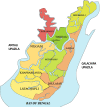Malnutrition and other risk factors of geriatric depression: a community-based comparative cross-sectional study in older adults in rural Bangladesh
- PMID: 34663237
- PMCID: PMC8524994
- DOI: 10.1186/s12877-021-02535-w
Malnutrition and other risk factors of geriatric depression: a community-based comparative cross-sectional study in older adults in rural Bangladesh
Abstract
Background: Malnutrition and depression are highly prevalent in older adults and can lead to disparaging outcomes. Analytical studies on geriatric depression (GD) and its association with malnutrition are very scarce in Bangladesh, although the size of the older population is increasing fast in the country. The current study aimed to assess the association between malnutrition and depression and associated risk factors in rural older adults.
Methods: A community-based comparative cross-sectional study was conducted in 600 older adult residents (aged ≥60 years) of three rural communities of Bangladesh from January to October 2019. The study enrolled two groups of participants; 300 depressed as cases and another 300 non-depressed older adults as a comparison group matching their age and living area. We used a semi-structured questionnaire to collect data through a face-to-face interview. Geriatric Depression Scale-15 was used to determine depression, and a score of ≥5 was considered as depressed. We used the Bangla version of the Mini-Nutritional Assessment-Short Form to assess nutritional status, which comprised questions related to appetite, weight loss, mobility, recent illness/stress, dementia/depression, and BMI, and considered a score of 0-7 as the cutoff score for malnutrition. Measures included baseline and personal characteristics, malnutrition, GD, and its associated risk factors. A binary logistic regression model was fitted to identify variables associated with the risk of GD.
Results: The study found no significant difference in gender (male Vs. female) between depressed (44.0% Vs. 56.0%) and non-depressed (46.0% Vs. 54.0%) older individuals. The study revealed that malnutrition was significantly (p < 0.01) higher in depressed (56.0%) than in non-depressed (18.0%) rural older adults. The malnourished older adults had around three times (AOR = 3.155; 95% CI: 1.53-6.49, p = 0.002) more risk of having depression than the well-nourished older individuals. Older adults who were unemployed (AOR = 4.964; 95% CI: 2.361-10.440; p = 0.0001) and from lower and middle class (AOR = 3.654; 95% CI: 2.266-7.767; p = 0.001) were more likely to experience depression. Older adults having a 'poor diet' were more likely to experience depression (AOR = 3.384; 95% CI: 1.764-6.703; p = 0.0001). The rural older adults who were single (AOR = 2.368; 95% CI: 1.762-6.524; p = 0.001) and tobacco users (AOR = 2.332; 95% CI: 1.663-5.623; p = 0.003) were found more likely to experience depression.
Conclusions: A significant association between malnutrition and depression was evident by the current study in the rural older individuals of Bangladesh. It will be a prolific initiative if policymakers merge malnutrition and the risk factors associated with geriatric depression in providing universal health care for better health and well-being of the rural older populations.
Keywords: GDS; Geriatric depression; MNA-SF; Malnutrition; Older adults; Rural Bangladesh.
© 2021. The Author(s).
Conflict of interest statement
The authors declare that they have no competing interests.
Figures
Similar articles
-
Factors associated with the nutritional status of the older population in a selected area of Dhaka, Bangladesh.BMC Geriatr. 2021 Mar 5;21(1):161. doi: 10.1186/s12877-021-02068-2. BMC Geriatr. 2021. PMID: 33673811 Free PMC article.
-
Level of malnutrition and associated factors among community-dwelling rural older adults in Fogera Zuriya district, Northwest Ethiopia.Nutrition. 2023 Sep;113:112085. doi: 10.1016/j.nut.2023.112085. Epub 2023 May 25. Nutrition. 2023. PMID: 37343390
-
The assessment of geriatric malnutrition, geriatric depression and associated co-morbidities among forcibly displaced Myanmar nationals in Bangladesh.Public Health Nutr. 2023 Oct;26(10):2048-2055. doi: 10.1017/S1368980023001556. Epub 2023 Aug 2. Public Health Nutr. 2023. PMID: 37529859 Free PMC article.
-
Validity of Nutritional Screening Tools for Community-Dwelling Older Adults: A Systematic Review and Meta-Analysis.J Am Med Dir Assoc. 2019 Oct;20(10):1351.e13-1351.e25. doi: 10.1016/j.jamda.2019.06.024. Epub 2019 Aug 10. J Am Med Dir Assoc. 2019. PMID: 31409560
-
Identifying the elderly at risk for malnutrition. The Mini Nutritional Assessment.Clin Geriatr Med. 2002 Nov;18(4):737-57. doi: 10.1016/s0749-0690(02)00059-9. Clin Geriatr Med. 2002. PMID: 12608501 Review.
Cited by
-
Association between Controlling Nutritional Status (CONUT) Score and Body Composition, Inflammation and Frailty in Hospitalized Elderly Patients.Nutrients. 2024 Feb 20;16(5):576. doi: 10.3390/nu16050576. Nutrients. 2024. PMID: 38474705 Free PMC article.
-
Mediation of nutritional status between the number of teeth and depressive symptoms in multi-ethnic older adults from Western China.Front Public Health. 2025 Apr 29;13:1506640. doi: 10.3389/fpubh.2025.1506640. eCollection 2025. Front Public Health. 2025. PMID: 40365427 Free PMC article.
-
Association between Geriatric Nutritional Risk Index and Depression after Ischemic Stroke.Nutrients. 2022 Jun 29;14(13):2698. doi: 10.3390/nu14132698. Nutrients. 2022. PMID: 35807878 Free PMC article.
-
Risks of undernutrition and depression in hospitalized patients: A cross-sectional study.Medicine (Baltimore). 2023 Sep 8;102(36):e35133. doi: 10.1097/MD.0000000000035133. Medicine (Baltimore). 2023. PMID: 37682139 Free PMC article.
-
Systematic Review and Meta-analysis of the Association Between Malnutrition and Risk of Depression in the Elderly.Alpha Psychiatry. 2024 Mar 1;25(2):183-189. doi: 10.5152/alphapsychiatry.2024.231336. eCollection 2024 Mar. Alpha Psychiatry. 2024. PMID: 38798803 Free PMC article. Review.
References
-
- The World Bank. Bangladesh Poverty Assessment: Facing old and new frontiers in poverty reduction. 2019.
-
- World Health Organization. World report on ageing and health. WHO Library Cataloguing-in-Publication Data; 2015. https://www.who.int/ageing/publications/world-report-2015/en/. Accessed 20 Jan 2019.
-
- Khan AHU. Geriatric population and relevant contemplation. Bangladesh Med J. 2014;43(2):112–7.
MeSH terms
LinkOut - more resources
Full Text Sources
Medical


